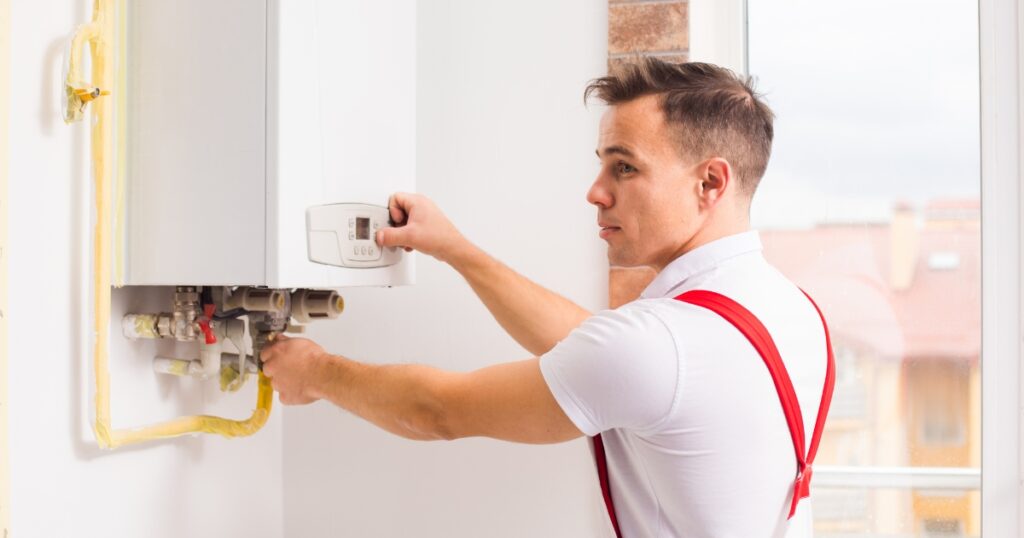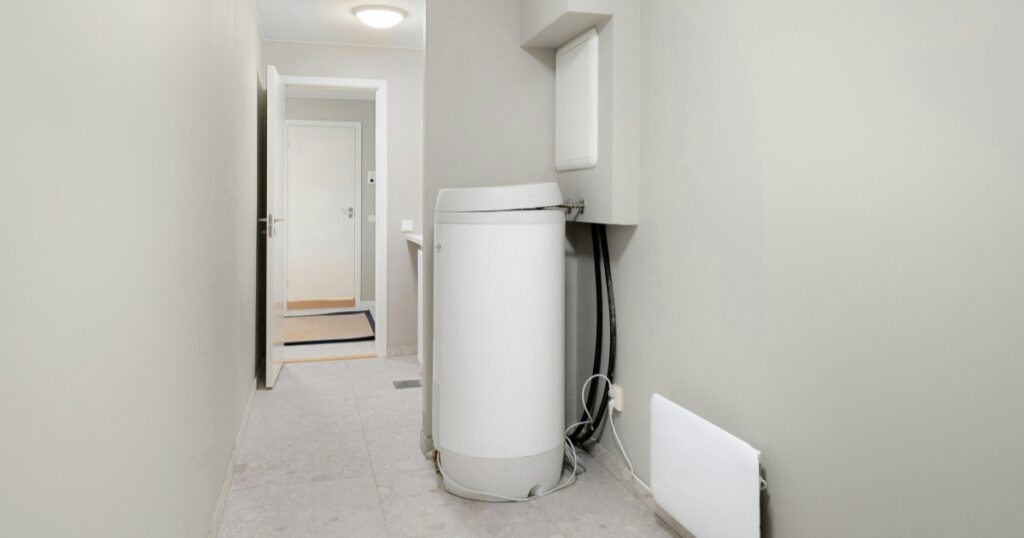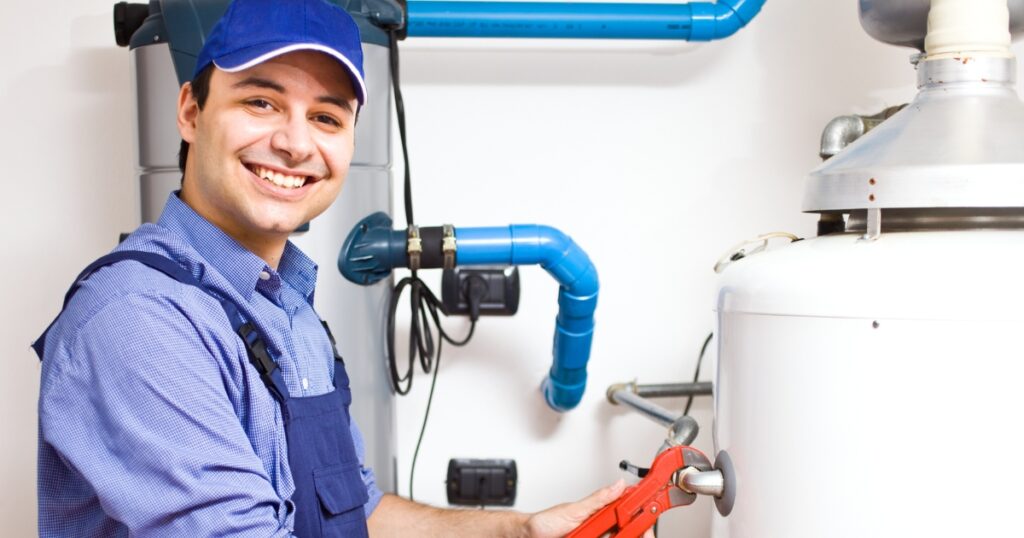Ever had the misfortune of twisting your hot water tap, expecting a hearty gush, only to cop a feeble dribble instead? It’s enough to get your blood boiling – and not just the water.
If you reckon sediment might be choking up your pipes like peak-hour traffic on the M1, then fear not. In this yarn, we’ll suss out the likely suspects screwing with your pressure and give you some fair dinkum fixes to sort out that rebellious plumbing.
Stick around to learn how you can send that lacklustre flow packing!
Key Takeaways
- Regularly inspect and clean taps, showerheads, and filters to prevent blockage by sediment and debris that can cause low hot water pressure.
- Annual maintenance of your hot water system, including flushing out sediment from the tank, is key to avoiding buildup that reduces efficiency and pressure.
- If experiencing inconsistent or low hot water pressure, check for faulty valves or regulators that may need adjusting or replacing to restore proper flow.
- Corrosion in old pipes can restrict water flow; consider having them assessed by a professional plumber for potential replacement.
- Early detection and repair of any leaks in the plumbing system help maintain optimal hot water pressure and prevent wastage of both water and energy.
Understanding Low Hot Water Pressure
Having low hot water pressure can be frustrating and impact your daily routine. It’s important to understand the common causes and symptoms so you can diagnose and solve the issue effectively.

Common Causes
Low hot water pressure frustrates many of us at home. It can turn simple daily tasks into tedious chores. Let’s dive into the usual suspects behind this issue:
- Dirt and debris in your taps and showerheads are often to blame for blocking the flow of hot water. Every so often, these fixtures need a good clean to let the water run smoothly.
- Sediment build-up in your water heater is another common culprit. Over time, minerals from hard water accumulate at the bottom of the tank, hampering water pressure.
- Faulty tempering valves that regulate the temperature by mixing hot and cold water can sometimes malfunction, leading to reduced hot water pressure.
- Water leaks anywhere along your plumbing system may not be immediately visible but can significantly drop your hot water pressure.
- If you have blocked filters, especially in appliances that use hot water, they might restrict flow and decrease pressure substantially.
- A failing pressure regulator designed to stabilise the water pressure throughout your home could be incorrectly calibrated or broken, causing low pressure for both cold and hot water.
- Partially closed valves might appear fully operational but if they’re even slightly turned off, they can massively affect your hot water supply.
- Corrosion or rust inside older pipes restricts the flow of water and reduces its force. This corrosion gradually narrows pipes’ insides over the years.
- Discrepancies between cold and hot water flow rates signal issues within your hot-water-specific pipeline or equipment.
Symptoms
Experiencing low hot water pressure can be frustrating. Be on the lookout for the following symptoms to identify the issue:
- Unusually long time to fill your bathtub or sink with hot water
- Inadequate hot water flow from your showerhead or tap, causing inconvenience during daily use
- Sputtering or irregular flow of hot water, which can disrupt your bathing and household tasks
- Fluctuating hot water temperatures when using different fixtures, indicate a potential problem with the hot water system
- The presence of air bubbles in running hot water may point to an underlying issue in the plumbing
Impact on Daily Life
Low hot water pressure can significantly disrupt daily activities, making it frustrating to take showers, wash dishes, or do laundry. Reduced water flow from taps and showerheads can lead to longer wait times for hot water and difficulties in thoroughly rinsing soap and shampoo.
Additionally, poor hot water pressure may affect the effectiveness of appliances like dishwashers and washing machines, resulting in subpar cleaning results. It’s important to address low hot water pressure promptly to restore convenience and efficiency to household tasks.
Diagnosing the Cause of Low Hot Water Pressure
When it comes to diagnosing the cause of low hot water pressure, it’s essential to consider blocked pipes, issues with taps, sediment and scale build-up, faulty plumbing, malfunctioning valves, and blocked filters.
These common problems can have a significant impact on your daily life and need to be addressed promptly for an efficient hot water system.
Blocked Pipes
If you are experiencing low hot water pressure, blocked pipes could be the culprit. Debris and sediment can accumulate in the pipes over time, restricting the flow of hot water to your fixtures.
This buildup may result in decreased water pressure and potentially cause additional issues if left unaddressed. It is essential to consider this possibility when troubleshooting low hot water pressure problems and take steps to clear any obstructions within the piping system.
Addressing blocked pipes by clearing out debris and sediment may help restore normal water pressure in your hot water system. This simple maintenance task can often be tackled without professional assistance, helping to improve the overall performance of your home’s plumbing system.
Issues with Taps
When experiencing low hot water pressure, issues with taps can be a common culprit. Sediment buildup or mineral deposits in tap fittings and aerators can restrict the flow of hot water, leading to reduced pressure.
Additionally, faulty tap washers or cartridges may result in leaks that further decrease the overall hot water pressure in the system. It’s important to regularly clean and maintain tap fittings and promptly address any leaks to ensure optimal hot water flow throughout your home.
If left unaddressed, tap-related issues can exacerbate low hot water pressure problems, impacting the functionality of various fixtures such as showers and sinks. Homeowners should routinely inspect taps for signs of sediment buildup or leaks and take proactive measures to resolve these issues.
Sediment and Scale Build-up in Hot Water System
Sediment and scale build-up in hot water systems can lead to low water pressure. Over time, mineral deposits from the water supply can accumulate in the system, resulting in restricted flow and reduced pressure.
This build-up often occurs in pipes, valves, and faucets, causing blockages that impede the smooth passage of hot water.
The accumulation of sediment and scale can also affect the efficiency of appliances like hot water tanks by reducing their heating capacity. Regular maintenance is vital to prevent sediment and scale build-up.
Faulty Plumbing
Faulty plumbing in hot water systems can lead to low hot water pressure, causing frustration and inconvenience. This issue can stem from various factors, such as corroded or rusty pipes, partially closed or broken shutoff valves, or obstructions within the pipes.
It’s essential to address these problems promptly to prevent further damage and restore adequate hot water pressure throughout the system. Professional plumbing assistance may be required to accurately diagnose and rectify the issues related to faulty plumbing in hot water systems.
Malfunctioning Valves
Moving on from addressing faulty plumbing issues, malfunctioning valves can also contribute to low hot water pressure in your system. These valves play a crucial role in controlling the flow of water throughout your home.
When these valves malfunction, they can restrict or disrupt the flow of hot water, leading to decreased pressure at your fixtures and taps.
Addressing malfunctioning valves is essential for maintaining optimal hot water pressure in your home. It’s important to have a professional plumber inspect and replace any faulty or damaged valves to ensure that your hot water system operates efficiently and provides consistent pressure throughout your home.
Blocked Filters
Blocked filters are a common culprit for low hot water pressure in systems. Debris and sediment can accumulate, restricting the flow of water through the filter. This can lead to a noticeable decrease in water pressure from taps and showerheads throughout the home.
Regular maintenance that includes cleaning or replacing filters is essential to ensure consistent hot water pressure.
When left unchecked, blocked filters can also impact the overall efficiency of the hot water system. As debris builds up, it puts added strain on the system, potentially leading to further issues down the line.

Solving Low Hot Water Pressure Issues
We can solve low hot water pressure issues by clearing blocked pipes, replacing faulty taps, flushing out sediment, fixing plumbing issues, and replacing valves and filters. Find out more about how to improve your hot water pressure in our blog!
Clearing Blocked Pipes
To clear blocked pipes, we may need to follow these steps:
- Use a plunger to dislodge any blockage in the pipe, ensuring there is a tight seal around the drain or outlet.
- If the plunger does not work, try using a plumbing snake or auger to physically remove the blockage from the pipe.
- Consider using a chemical drain cleaner after assessing the material of your pipes and conducting proper research to ensure it is safe to use on your specific piping material.
- Flush the pipes with hot water to help dislodge any remaining debris and clear out the system.
- If these measures don’t resolve the issue, it may be necessary to seek professional plumbing assistance for further diagnosis and possible solutions.
Replacing Faulty Taps
Low hot water pressure can be caused by faulty taps. This can result from sediment and debris buildup, faulty washers, or worn-out components. To address this issue, homeowners can consider the following actions:
- Inspect the tap for visible signs of wear and tear, including leaking or irregular water flow.
- Turn off the water supply to the affected tap by shutting off the corresponding valve or using the main shut-off valve.
- Disassemble the tap to check for damaged or worn-out washers, O-rings, or other internal components.
- Replace any faulty parts with new components that are compatible with the specific tap model and brand.
- Reassemble the tap carefully, ensuring all parts are properly fitted and sealed to prevent leaks.
- Turn on the water supply and test the tap to check for regular water flow and to ensure that there are no leaks.
Flushing Out Sediment
To improve hot water pressure, flushing out sediment is essential. Sediment can accumulate in the hot water system over time, causing blockages and reducing flow. Here’s what you can do:
- Turn off the power or gas supply to the hot water unit.
- Open all hot water taps in your home to drain any remaining hot water from the system.
- Locate the drain valve at the base of the hot water storage tank and connect a hose to it to direct the flow of water away from the tank.
- Open the drain valve and allow the water to run for several minutes, flushing out any sediment that has settled at the bottom of the tank.
- Close the drain valve and remove the hose once clean water is flowing out consistently.
- Turn on the power or gas supply to the hot water unit and let it refill.
- Finally, close all of your previously opened taps and check for improved hot water pressure throughout your home.
Fixing Plumbing Issues
To address plumbing issues impacting hot water pressure, it is important to check for leaking pipes and repair or replace them if necessary. Additionally, consider the following steps to fix plumbing issues that may be causing low hot water pressure:
- Inspect all visible pipes for signs of corrosion, leaks, or damage.
- Replace any corroded or damaged pipes to ensure proper water flow and consistent pressure.
- Check for loose or improperly connected pipe fittings, and resecure them as needed.
- Test and recalibrate the pressure regulator to ensure optimal water pressure throughout the hot water system.
- Consider installing expansion tanks if the fluctuations in water pressure are due to thermal expansion in the plumbing system.
- Consult with a professional plumber if you suspect complex issues within the hot water plumbing system.
Replacing Valves
To address low hot water pressure caused by faulty valves, it’s essential to consider replacing them with new, fully functional ones. Here are steps to replace valves and restore the hot water pressure in your system:
- Turn off the water supply: Locate the main shutoff valve for your hot water system and turn it off to stop the flow of water.
- Drain the system: Open a nearby faucet or tap to drain any remaining water from the pipes and relieve pressure.
- Remove the old valve: Use appropriate tools to disconnect the old valve from the plumbing system, ensuring that no residual water is left in the pipes.
- Install the new valve: Carefully follow manufacturer instructions to securely install the new valve, ensuring proper alignment and tight connections.
- Turn on the water supply: Once the new valve is securely installed, turn on the main shutoff valve and test for leaks or any issues with water flow.
- Check for proper functionality: Turn on hot water taps throughout your home to ensure that the replacement has effectively restored adequate pressure.
- Seek professional assistance if needed: If you encounter challenges during this process or if low hot water pressure persists, don’t hesitate to consult a professional plumber for further diagnosis and solutions.
Replacing Filters
Low hot water pressure can be improved by replacing filters. Sediment and debris can accumulate in the filters over time, leading to decreased water flow. By routinely replacing filters, you can ensure that the hot water system operates efficiently and maintains optimal water pressure.
- Regularly check and replace the filters in your hot water system to prevent sediment and debris from clogging the system.
- Ensure that the replacement filters are compatible with your specific hot water system to maximise their effectiveness.
- Follow the manufacturer’s guidelines for replacing filters to maintain proper water pressure and improve the longevity of your hot water system.
- Consider consulting a professional plumber to assist with replacing filters and ensuring they are installed correctly for optimal performance.
- By regularly replacing filters in your hot water system, you can prevent blockages and maintain consistent high water pressure throughout your home.
- Keep track of the filter replacement schedule and set reminders to replace them at recommended intervals to avoid low hot water pressure issues.
- Replacing filters promptly can significantly improve the overall performance of your hot water system, ensuring a reliable and consistent hot water supply throughout your home.
- Proper maintenance, including regular filter replacements, is essential for preventing low hot water pressure caused by clogged or blocked filters.
- Considering investing in high-quality replacement filters designed to effectively remove sediment and debris, optimises your hot water system’s performance.
- Timely replacement of filters in your hot water system helps to maintain optimal water pressure and ensures an uninterrupted supply of hot water for daily use.
Preventing Low Hot Water Pressure
To prevent low hot water pressure, regular maintenance is key. Properly sizing water lines and ensuring proper installation is also crucial in preventing any potential issues with low hot water pressure.
Addressing leaks and water pressure issues early on can help maintain a healthy hot water system.
Regular Maintenance
To maintain proper hot water pressure, it’s important to schedule regular maintenance for your hot water system. This includes checking for leaks, clearing any sediment or debris from taps and showerheads, and inspecting the pressure regulator and valves for any signs of damage.
Regular maintenance can help prevent low hot water pressure issues by ensuring that all components are in good working condition and identifying any potential problems before they escalate.
Additionally, this proactive approach can also extend the lifespan of your hot water system while maintaining optimal performance.
By scheduling regular maintenance as part of your home care routine, you can address any potential low hot water pressure causes early on and minimise the risk of more significant plumbing problems down the line.
Properly Sizing Water Lines
To ensure optimal hot water pressure, we must properly size the water lines in our plumbing system. Water lines that are too small can cause a decrease in water pressure, leading to inadequate hot water flow.
By correctly sizing the water lines, we can maintain consistent and adequate water pressure throughout our home’s hot water system.
Properly sized water lines help prevent issues such as low hot water pressure and uneven flow rates between the hot and cold taps. This proactive approach ensures that our fixtures receive an adequate supply of hot water without any unnecessary strain on the plumbing system.
Proper Installation
After ensuring that the water lines are properly sized, the next crucial step in maintaining adequate hot water pressure is proper installation. Proper installation of fixtures and components plays a significant role in preventing low hot water pressure issues.
When fixtures are installed correctly, they minimise the potential for leaks and blockages that can affect hot water pressure. One important aspect of proper installation is ensuring that all connections and fittings are secure to maintain consistent hot water flow throughout the system.
Installing pressure regulators at strategic points in the plumbing system can also help to regulate and maintain optimal hot water pressure levels. Additionally, choosing suitable tapware and valves designed to withstand varying pressures can contribute to reliable performance over time.
Addressing Leaks and Water Pressure Issues Early On
Address leaks and water pressure issues early on to prevent more significant problems down the line. Even small leaks can lead to decreased hot water pressure, impacting your daily activities.
Regularly check for and promptly address any leaks in your hot water system to maintain optimal water pressure throughout your home.
Additionally, keep an eye out for any sudden changes in hot water pressure as this could indicate issues with the water supply itself or potential obstructions within the pipes. By addressing these concerns early on, you can avoid costly repairs and ensure consistent hot water flow throughout your property.
Address Your Hot Water Problems Today
In conclusion, troubleshooting low hot water pressure is vital for a comfortable home. Regular maintenance and proper installation are crucial to prevent issues. Solving low hot water pressure problems requires clearing blocked pipes, flushing out sediment, and fixing faulty taps.
It’s essential to address leaks and water pressure issues early on to maintain an efficient hot water system.






